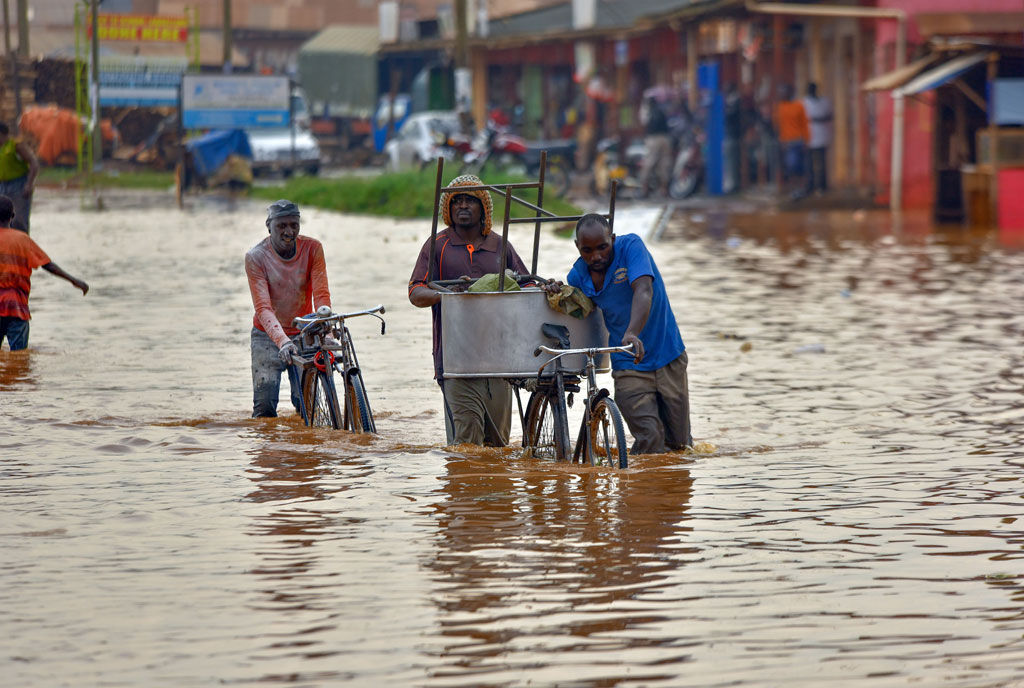Inside Uganda’s murky carbon offset markets

According to the National Emergency Coordination and Operations Centre (NECOC), a loose outfit for disaster risk monitoring and profiling, in the Office of Prime Minister (OPM), large swathes of the Mt Elgon ranges are uninhabitable owing to susceptibility to a myriad of climate-related risks.
The highland districts of: - Bududa, Mbale, Kween, Manafwa, Sironko, Namisindwa and Bukwo are prone to land/mudslide, while the lowlands of Namayingo, Namutumba, and Paliisa, experience intermittent flash floods and droughts.
It is for the same reason that the sub-region, during the last decade, has attracted millions of dollars of climate financing for disaster risk mitigation and adaptation, although precise figures are difficult to come by. Afforestation and reforestation are the commonest interventions undertaken, particularly in the highland districts.
Conversely, there is growing appetite, both public and commercial, for tree planting activities across the country, fueled by among others the exponential demand for wood and timber, and climate change adaptation programmes including the opaque carbon offset schemes.
The carbon offset schemes have among others propelled a myriad sustainable solutions, from clean cooking initiatives to renewable energy such as solar, in the quest for gradual reduction of greenhouse gasses; carbon dioxide (CO2), methane, and nitrous oxide.
Until 2015, Ms Beatrice Mutonyi was fully conscious of the benefits of trees but didnât see reason to plant any around her home and small farmland in Kitimolowa village, Nyondo sub-county in Mbale district; after all, firewood, fruits, etc, can be bought.
âAn NGO called Eco Trust came to our subcounty and they talked to us about the benefits of tree plantingâ¦We organised 36 of us and went to the sub-county headquarters where we were trained about the benefits of planting trees, and how. After the training we received some money which we shared as a group to buy [local] tree saplings which we planted,â Ms Mutonyi recalled.
She: âAfter some time, the NGO people came back here to measure our land against how many saplings we wanted to plant. They also guided us on what to do. After a while, another group followed up on how the trees were growing; we were given some money, that was zero year, and they told us they would keep monitoring us. They also said that the donors just wanted carbon, while the trees were ours but they would keep paying us.â
Over the years, Ms Muntonyi acknowledged that she has been receiving payments, albeit in varying sums. She was non-committal on disclosing the amounts. But according to her explanation and those of other residents talked to, the payments depend on the amount of carbon captured from a given acreage of the trees.
The residents also delighted in the multipurpose of the venture; they mostly planted fruit trees, mangoes, and avocadoes, among others, which they harvest as they receive payments for carbon credits generated. The majority of women-led households are scattered across the sub-country the money comes in handy for this and that.
Ms Mutonyiâs group has since grown to 300 members, so they deemed it fit to mobilise themselves into a savings scheme, Bubetye Carbon Farmers Association, which comes with a host of benefits.
Of course all is not rosy: sometimes the payments take long to come. They also totally have no idea about the computation of the carbon offset metrics leading to how much they are paid.
Cash for carbon
Ms Mutonyi and group were introduced to the tree planting-for-cash scheme as part of the Trees for Global Benefit (TGB), a climate disasters mitigation and social and economic development initiative implemented by a local NGO based in Entebbe, Environmental Conservation Trust of Uganda (Eco Trust).
The TGB, the Mbale District environment officer, Mr Charles Wekube explained, was an offshoot of the Territorial Approach to Climate Change (TACC), one of the National Adaptation Programmes of Action [NAPA], or first climate change adaptation projects generated by Uganda. The TACC, which mainly comprised planting trees on fragile slopes to hold the soils compact, was funded through the UNDP.
âOne of the ways of sustainability of the TACC was starting the carbon financing project,â Mr Wekube noted, and added: âTree planting is a key mitigation measure, so we decided to take forward interventions that reduce Co2 emissions from the atmosphere. We sensitised our communities on the importance of planting particularly Indigenous trees, but it was purely a voluntary scheme. After some time, they started accepting and they were signed up to plant trees.â
He explained that the trees are for offsetting carbon emissions, for which then the farmers are paid. The scheme runs for ten years.
âHow it works; the first year of planting is categorised as zero years, attracting a 20 percent payment: the second-year 30 percent the third year, 10 percent; the fourth year is skipped; the fifth year, 10 percent; the sixth year is skipped; the seventh year, 20 percent; the eighth year is skipped; the ninth year, 10 percent,â Mr Wekube said.
He added: âAfter 10 years it is assumed the trees are grown but the farmers can keep them if they wishâ¦Why the incentive is stopped is because they can be harvested.â
Asked about the metrics of measuring the carbon and the sometimes-meagre payments, which farmers bemoaned, Mr Wekube said the NGO manning the project on the ground âhas the metrics it usesâ and on which it bases to effect the payments. He, however, defended that the NGO is closely monitored and evaluated by the district local government.
According to a May 2022 report by Eco Trust, Mbale District âhas consistently performed well in farmer recruitment for the past three years given the fact that farmers in the area have the smallest land sizes. The farmers have small pieces of land but through group recruitment farmers have since joined the project in big numbers.â
Inversely, a November 2022 study titled, âTrees for Global Benefit Uganda: A Case Study on the Failures of Carbon Offsetting,â detailed that under the project at least 15,000 farmer households across 14 districts have planted over 2.3million trees, as part of Trees for Global Benefit since 2003, sequestering over two million tonnes of Co2.
However, the report by the Global Forest Coalition, notes that: âBeyond the fact that carbon offsetting is not the answer to climate change, these other important questions on justice, equity, and local economic, health, and social impacts of these projects require scrutiny. Discussions with community members in the districts of Hoima and Kikuube revealed significant problems with the project that suggest it has failed to achieve its objectives and is causing more harm than benefit and must therefore be rethought.â
Opaque trade
In Uganda, like across the world, there is growing concern about the carbon markets. There are concerns about the opaqueness of the market which comprises buyers, sellers, brokers and middlemen.
A woman uses an energy saving stove to cook porridge. According to a 2022 SNV report, close to 90% of the population in Uganda cooks on open fires or inefficient cook stoves. PHOTO/MICHAEL KAKUMIRIZI
Critics argue that there is a general lack of awareness of the carbon offset markets and how they work, and yet NGOs are signing up mostly impoverished communities on long term tree planting schemes or for energy solutions such as lights and cooking stoves. However, there is hardly a register to track or tack stock of such operations.
There are also question marks on the methodologies used to compute the carbon credits. For instance, if a carbon credit fetches as high as $30 how much should go to the farmer.
The Commissioner for Climate Change in the Ministry of Water and Environment, Ms Margaret Athieno Mwebesa, told Monitor in an interview that in many instances âit is communities that are being cheatedâ.
âWe are coming up with climate change mechanisms which also include carbon markets credit trade regulations to regulate the market. We want a very transparent platform so that all players can come and benefit,â she said, adding: âWe have so many NGOs coming here and are already engaging our farmers, and we want to come in; the reason being is we want fair trade for all of us.â
Carbon markets, according to the African Development Bank (AfDB), refers to a set of systems that are regulated in different jurisdictions for trading greenhouse gas pollution rights.
âThese rights â called allowances or permits â are the commodity that is globally traded and give the bearer the right to emit an equivalent amount of CO2 emissions. Carbon credits are similar to permits but are fundamentally different in that they are generated over time, (i.e., once a project gets implemented and the reductions are audited). In many markets, these carbon credits can be used in lieu of allowances for compliance to targets that have been placed on industrial facilities or sovereign countries,â the AfDB stated.
A May 2024 report titled âVoluntary Carbon Markets in Africa; A Deep Dive into Opportunities and Challengesâ, detailed that carbon markets are organised into a primary market, involving transactions conducted within a formalised system, and a secondary market, transactions conducted outside of these systems, typically through bilateral agreements.
Ms Mwebesa admitted that there âvery many brokers in the country already doing trade and our communities are not benefiting yet they are the asset ownersâ.
âWe want proper trade. We want fair trade. For instance, if a project is going to be on my land, I should get my portion properly. The broker shouldnât get a bigger chuck, and I get peanuts,â Ms Mwebesa said of the current system.
Voluntary carbon offset market, reinforced by Article Six of the 2015 Paris Agreement, is a growing business and lauded in some quarters as a new mechanism for climate change financing across the globe.
Corporate Companies too, around the world, are latching strappingly under the âcap and tradeâ arrangement to overshoot their greenhouse emissions targets set by regulators, and willing to pay fines or offset carbon elsewhere particularly in poor countries. Critics have argued that this allows development countries to pay lip service to cutting net emissions while pushing poor countries in the Global South not to âmordeniseâ or undertake key development paths in order not to worsen the greenhouse emissions crisis.
Insiders attribute the fierce opposition against Ugandaâs $10 billion (Shs36 trillion) oil project in southwestern Uganda to this arrangement strongly cloaked in the climate justice movement by the powerful climate lobby in western capitals. In essence the environment lobby in Europe wants Ugandaâs oil to remain in the ground, while European companies are on a drilling spree elsewhere.
Climate profiteering
âSo, a powerful steel company from Europe or America will come to Africa and engage any partner to capture a certain level of carbon which is then transmitted to the other side. So the company in Europe will over pollute well knowing someone in Africa is capturing on their behalf,â noted Mr Anthony Wolimbwa, the National Coordinator for the Climate Action Network Uganda, which works on climate action.
He added: âNow that is a seriously fundamental problem. Whereas it is generating money, itâs creating inequality in development. What it means is that let those guys pollute, we give you some money. But you donât determine the money. Those are some of the challenges in these innovative climate finance mechanisms.â
Residents relocate from Namirembe Landing Site with their household items following flooding in Masaka City on May 12, 2024. PHOTO/FILE
Size of carbon market
In terms of size, the carbon market size is said to be worth billions of dollars. As of 2022 the voluntary carbon trading market was said to be $2 billion (Shs7.4 trillion), with potential to grow by over 15 times by 2030. However, due to the myriads of issues including claims of human rights abuses, a May 2024 report by Ecosystem Marketplace, that publishes carbon market trends, the market had tanked from $2 billion to $723 million (Shs2.6 trillion) in 2023.
Uganda, Water and Environment Minister Beatrice Anywar told the parliamentary Committee on Climate Change on July 20, 2023, is one of the carbon market frontrunners in Africa, with a total of over 30.6 million tonnes of carbon credits issued under the Clean Development Mechanism and Voluntary Carbon Market standards (CDM), from which methodologies for voluntary carbon market are derived.
The CDM allows emission reduction projects in developing countries to earn certified emission reductions (CERs), each equivalent to one tonne of carbon dioxide. âGovernment ratified the Paris Agreement and developed a climate action plan known as Nationally Determined Contributions (NDC). In 2022, the government committed to reduce emissions by 5.9 per cent below business-as-usual levels in 2030,â Ms Anywar told MPs.
In September 2022, the government updated its 2016 NDC buttressed by the policy blueprints, Vision 2040 and the National Development Plan (NDP) III which presents an ambitious economy wide mitigation target in 2030 of 24.7 percent reduction below the Business As Usual (BAU), a progression from the 22 percent reduction target communicated in 2016.
However, for Uganda, the opaqueness of the business and fragmentation of the carbon market system, leaves it subject to exploitation while offering minimal opportunity diversification.
Mr Wolimbwa said the regulations would go a long way in addressing the market imperfections.
âIn other ways, the way the locals are likely to be ripped off is that if there are no regulations. Someone is going to come and enter into agreement with a smallholder farmer to grow trees for 20 years on their land without cutting them. The problem is how much you are giving this person. Are you paying 1/2m per acre per year or 100k/? Now the farmer whoâs growing these trees cannot use the land but canât cut trees. Thatâs why we advocated for these regulations,â he noted.
He added: âThe farmer has not capacity to know how much a ton of carbon is trading in Europe or America. So, we are saying there must be fairness across the system which protects farmers, for taxes, and transparency. The moment those are lackingâ¦you know what to expect.â
Mr Emmanuel Etonu, the Elgon region coordinator of Integrated Seed and Sector Development (ISSD), which pushes for pluralistic and market-oriented seed solutions, explained that carbon credits being a new concept, it is yet to be fully grasped by majority in Uganda.
âWe did some bit of study about the viability of carbon credits in the Elgon region and because of the land tenure system, the fragmentation makes it difficult for communities to benefit from this because you need an expanse of land to give into for tree planting. In Bududa, we donât have this kind of land. People have small plots that they cultivate, but also when you look at the compensation that comes into the farmer, the opportunity cost of planting the trees may not be attractive to the farmer to forgo planting of crops for the trees,â Mr Etonu said.
Climate profiteering: Inside Ugandaâs murky carbon credit markets | Panorama
window.hasEmbeddedVideo = true;
Climate profiteering: Inside Ugandaâs murky carbon credit markets | Panorama









0 Comments